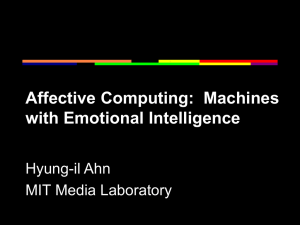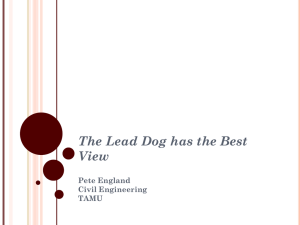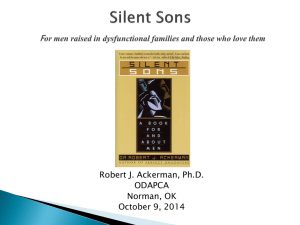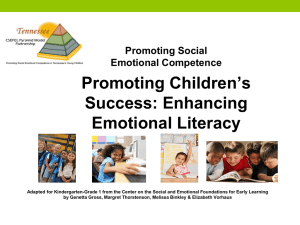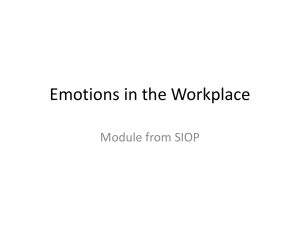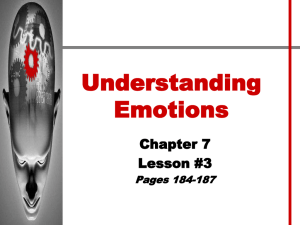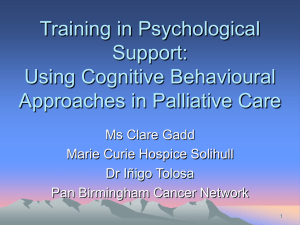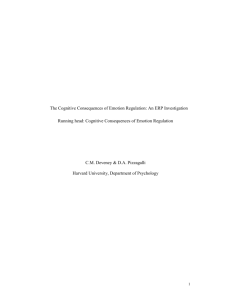My affective computing - Affective Computing Group
advertisement
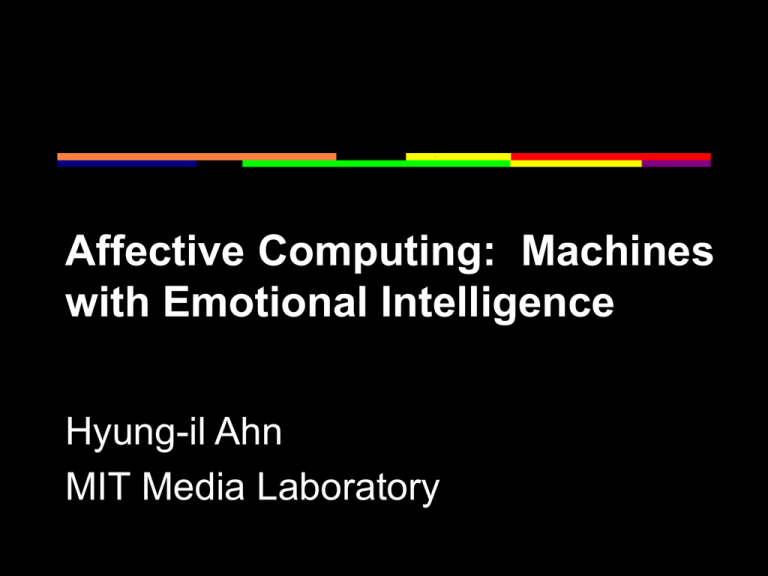
Affective Computing: Machines with Emotional Intelligence Hyung-il Ahn MIT Media Laboratory …doesn’t notice you are annoyed. [Doesn’t recognize your emotion] You express more annoyance. He ignores it. [Stupid about handling your emotion] He winks, and does a happy little dance before exiting. [Stupid about expressing emotion.] Skills of Emotional Intelligence: • • • • • Expressing emotions Recognizing emotions Handling another’s emotions Regulating emotions \ if “have emotion” Utilizing emotions / (Salovey and Mayer 90, Goleman 95) Research Areas • Robotic Computer - Recognizing another’s emotions - Expressing emotions - Handling another’s emotions • Affective and Cognitive Decision Making - Regulating and utilizing emotions - Affect as a self-adapting control system Affect changes the operating characteristics of other three domains (cognition, motivation, behavior) Recognizing Emotions Recognition of three “basic” states: Future “teacher for every learner” Can we teach a chair to recognize behaviors indicative of interest and boredom? (Mota and Picard) Sit upright Lean Forward Slump Back Side Lean Boredom Interest What can the sensor chair contribute toward inferring the student’s state: Bored vs. interested? Results (on children not in training data, Mota and Picard, 2003): 9-state Posture Recognition: 89-97% accurate High Interest, Low interest, Taking a Break: 69-83% accurate Detecting, tracking, and recognizing facial expressions from video (IBM BlueEyes camera with MIT algorithms) Autism Spectrum Conditions Center for Disease Control and Prevention (2005) – 1 child in 166 has ASC Mind-Read > Act > Persuade hmm … Roz looks busy. Its probably not a good time to bring this up Analysis of nonverbal cues Inference and reasoning about mental states Modify one’s actions Persuade others Real time Mental State Inference El Kaliouby and Robinson (2005) Facial feature extraction Head & facial action unit recognition Head & facial display recognition Mental state inference Head pose estimation Feature point tracking* * Nevenvision face-tracker hmm … Let me think about this Affective-Cognitive Mental States Baron-Cohen et al. AUTISM RESEARCH CENTRE, Agreeing CAMBRIDGE Complex Mental States (subset) Concentrating Absorbed Concentrating Vigilant Disagreeing Interested Thinking Unsure Asking Curious Impressed Interested Baffled Confused Undecided Unsure Assertive Committed Persuaded Sure Disapproving Discouraging Disinclined Brooding Choosing Thinking Thoughtful Physically animated Robotic Computer (joint with Prof. Cynthia Breazeal) Goal: increase user movement without distraction and annoyance, further social-rapport building Robotic Computer (RoCo): A physically animated computer Learning: the user can guide RoCo’s behavior by explicit and implicit rewards and punishments (Reinforcement Learning) tracking attentive (+) pleased (+) rewarding (+) punishing (-) attentive entertaining distracted stretching responding to pleasure responding to displeasure tracking tracking slumped pleased displeased rewarding punishing RoCo’s postures congruous to the user affect “Stoop to Conquer” : Posture and affect interact to influence computer users’ comfort and persistence in problem solving tasks People tend to be more persistent and feel more comfortable when RoCo’s posture is congruous to their affective state N=(17) Procedure and Tasks Tracing Task: a solvable and an unsolvable puzzle Decision-making Task (in Experiment 2): to make subjects keep the target posture longer Affective Cognitive Decision Making (Example 1) Two-armed bandit gambling tasks Inspired by Bechara & Damasio’s IOWA gambling tasks (Bechara et al. 1997) The left arm has ‘Negative Valence’ Arousal (uncertainty) as ‘feeling uneasy’ The right arm has ‘Positive Valence’ Arousal (uncertainty) as ‘feeling lucky’ (Example 2) Decision making under risk Loss aversion: People strongly prefer avoiding losses than acquiring gains • ‘Risk-Averse’ choices in the domain of ‘Likely Gains’ $3000 (Pr=1) > Option 1 Expected value = $3000 (Gain) $4000 (Pr=0.8) $ 0 (Pr=0.2) Option 2 < Expected value = $4000 * 0.8 + $0 * 0.2 = $3200 (Gain) • ‘Risk-Seeking’ choices in the domain of ‘Likely Losses’ - $3000 (Pr=1) < Option 1 Expected value = - $3000 (Loss) - $4000 (Pr=0.8) $ 0 (Pr=0.2) Option 2 > Expected value = - $4000 * 0.8 + $0 * 0.2 = - $3200 (Loss) The PT (Prospect Theory) value function ( x xref ) , x xref 0 v( x xref ) (( x xref )) , x xref 0 0 1, 0 1, 1 - Reference Dependence: gains and losses are defined relative to the reference point ( xref - Concave above the reference point - Convex below the reference point (Tversky & Kahneman) ) - Diminishing sensitivity: less sensitive to outliers for both gains and losses - Loss aversion: the function is steeper in the negative (loss) domain Endowment Effect • people place a higher value on objects they own relative to objects they do not. • In one experiment, people demanded a higher price for a coffee mug that had been given to them but put a lower price on one they did not yet own. • The endowment effect was described as inconsistent with standard economic theory which asserts that a person's willingness to pay (WTP) for a good should be equal to their willingness to accept (WTA) compensation to be deprived of the good. This hypothesis underlies consumer theory and indifference curves. • The effect is related to loss aversion and status quo bias in prospect theory. (Example 3) Effects of mood on decision making (Lerner & Keltner 2000, 2001, 2004) Happiness Optimistic about judgments of future events Pessimistic judgments of future events, Risk-Aversive choices Fear Anger Optimistic judgments of future events, Risk-Seeking choices Reverse Endowment Effect Sadness Subjective Value Function (mood influences decision making) Affective Cognitive Learning and Decision Making • A new computational framework for learning and decision making inspired by the neural basis of motivations and the role of emotions in human behaviors • A motivational value (reward)-based learning theory: decision value = extrinsic (cognitive) value + intrinsic (affective) value extrinsic value from the cognitive (deliberative and analytic) systems intrinsic value from multiple affective systems such as Seeking, Fear, Rage, and other circuits. • Probabilistic models: Cognition (cognitive state transition), Multiple affect circuits (Seeking, Joy, Anger, Fear, …), and Decision making model • Any prior and learned knowledge can be incorporated for expecting the consequences of decisions (or computing the cognitive value) Choice 1 Effort (r = -80) Fearless/ Neutral / Fearful Mood To destroy the ring in Mordor with less effort Prob Reward Incidental Emotions -30 0 20 70 Expected Values Cognitive Expectations choice 1 = 20, choice 2 = 20 Choice 2 Effort (r = -30) Valenced Uncertainty Values Anticipatory Emotions from the Seeking Circuit choice 1 = positive, choice 2 = negative Pr = 0.5 Fear Anticipatory Emotions from Other Circuits • Success (r = 100) • Fail (r = 0)



